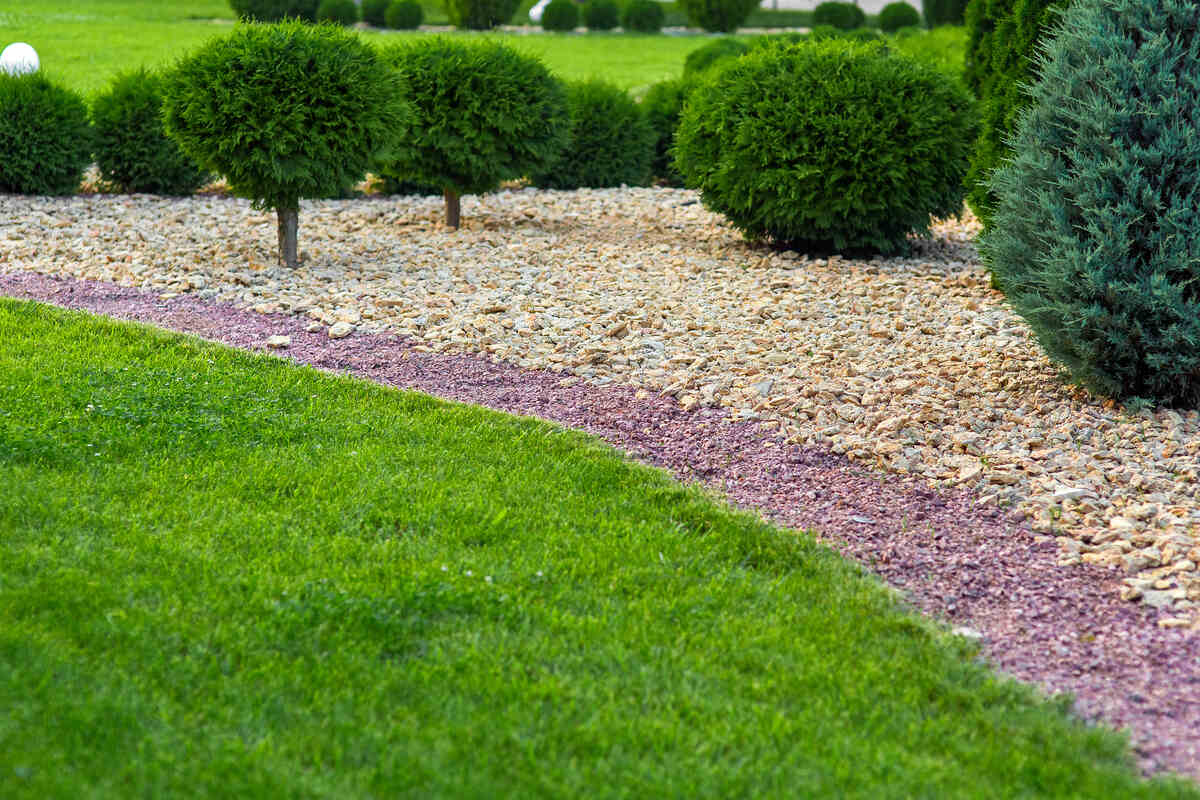
Dreading the hassle of replacing soggy organic mulch every year? Don’t worry. There are many types of inorganic mulch — like rocks, rubber, and plastic — that can give your yard a long-lasting, low-maintenance look.
In this article, we’ll explore what mulch is, the five main types of inorganic mulch, and the pros and cons of choosing them over organic options. We’ll also share some helpful tips for using them effectively in your landscape.
What Is Inorganic Mulch?
Inorganic mulch is made up of non-living natural or manufactured materials. This includes mineral elements (e.g., stones) and synthetic mulches (e.g., recycled tires). These materials don’t break down easily — some, like glass, never decompose, while others, like plastic, can take hundreds of years to degrade.
This means inorganic mulches won’t add nutrients to the soil like organic mulches, so they aren’t ideal if you’re looking to enrich your plants. However, since you don’t need to replace them as often, they’re perfect for a low-maintenance weed barrier and add a nice decorative touch to your landscape.
See Related:
5 Types of Inorganic Mulch
There are five types of inorganic mulch: rock, plastic sheeting, landscape fabric, rubber, and reflective. Spreading gravel around flower beds is an easy DIY project you can handle yourself. But installing aluminum mulch in your vegetable garden is better left to the pros.
The mulch you choose does more than affect the ease of application or your budget. It’ll also influence how much upkeep your yard needs and how it looks in the long run.
Let’s take a closer look at each type:
1. Rock
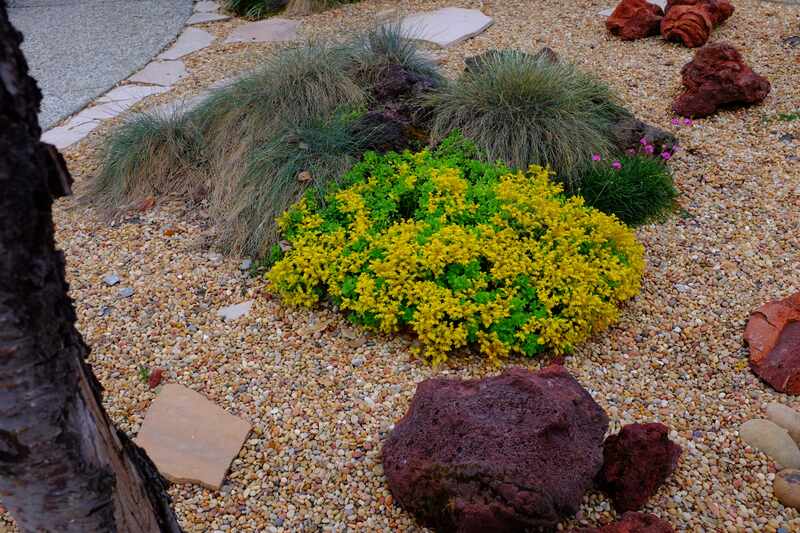
Rock mulches are a popular choice for their durability and easy upkeep. They come in all shapes and sizes, and you can find them in many different colors. Plus, they’re especially good at improving drainage.
Unlike other mulches that soak up rainwater, rocks let it flow right through. This means they can help prevent mudslides and soil erosion in areas with a lot of rain.
Some examples of rock mulch are:
- Gravel
- Decomposed granite
- Pebbles
- Lava rock
- Marble chips
- Crushed bricks
- River rock
- Limestone chips
Remember: Rock mulch heats up quickly in the sun and can scorch plant roots and make the surrounding soil hotter and drier. To protect your plants, leave at least 2 to 3 inches between the mulch and the plant stems. Also, consider adding a 1- to 2-inch layer of organic mulch underneath to help keep the roots cool.
Where to Mulch With Rocks
While it seems like a great way to avoid mulching annually, be mindful of where you mulch with rocks in the landscape. Why? Rock mulch reflects sunlight, which can stress plants with too much heat, and it can compact the soil underneath. Besides, rock mulch is heavier and more difficult to move around than organic mulch.
The best places to mulch with rock are:
- On pathways, driveways, and walkways
- Under downspouts
- Around fire pits and patios
- In rain gardens
- Along heat-tolerant garden borders
- In dry creek beds
Pro Tip: If you’re adding rock mulch to a sloped area, put larger rocks at the bottom to hold everything in place and stop the mulch from washing away during heavy rains. You can also install edging or use landscape fabric to keep the rocks stable and prevent them from shifting downhill.
Pros of Rock Mulch
- It’s low-maintenance.
- It allows water to drain quickly, preventing waterlogging and fungal diseases like root rot and pythium blight.
- It won’t fade, break down, or blow away easily.
- It can be found at most garden centers and hardware stores.
- It comes in many colors, sizes, and styles.
Cons of Rock Mulch
- It gets very hot in summer, and this heat can seep into the soil. This stresses your plants and makes them thirstier.
- It’s difficult to rake leaves or other debris off the top of a rock layer, so it’s not the best if you have a lot of trees in your yard or areas with heavy leaf drop.
- Without a layer of landscape fabric underneath, the rocks can slowly sink and get buried in the soil.
- In some cases, it can become a breeding ground for weeds. For instance, strong winds can blow fine soil and weed seeds right into the cracks between the rocks.
2. Plastic Film
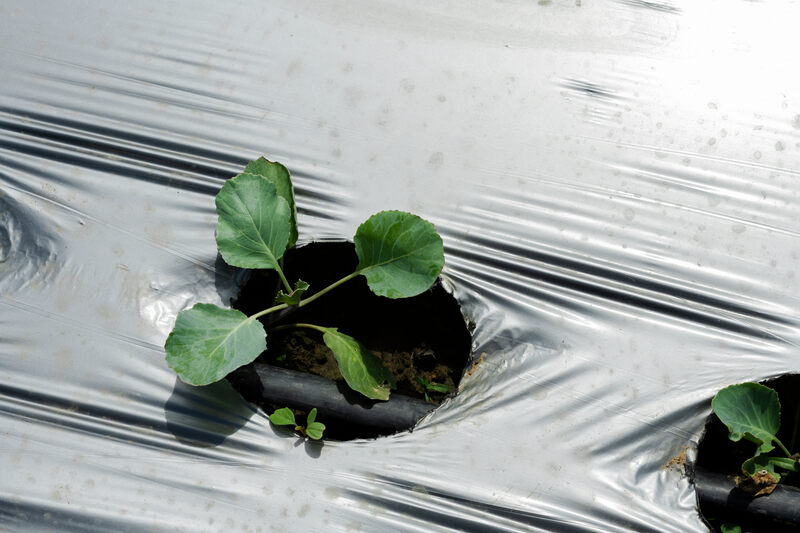
Plastic film is a type of landscape fabric that’s mostly used in agriculture to control weeds, but it’s also great for helping your vegetable garden thrive. There are a few different types of plastic mulch you can choose from, including:
- Black plastic: This is the most common and most affordable. Its dark color blocks sunlight, so weeds can’t sprout and compete with your veggies for water and nutrients.
- Clear plastic: Unlike black plastic, clear plastic lets sunlight reach the soil, which can be helpful for warming things up in early spring.
- White plastic: This type keeps the soil cooler by reflecting sunlight, so it’s ideal for hot climates.
- Soil-biodegradable plastic: This is a relatively new eco-friendly option. It breaks down over time when you mix it into the soil, which helps to reduce plastic waste and microplastic pollution.
You can also buy slick plastic with a smooth surface or embossed plastic with a diamond-shaped pattern. We recommend going with the embossed black plastic sheet. It doesn’t expand and contract as much with temperature changes, so it stays in place better and doesn’t loosen from the soil.
Note: To make sure your plastic mulch stays snug against the soil, try warming it up before laying it down. If you use cold plastic straight from storage, it can loosen up once the sun heats it in your garden — and if it does, it won’t warm the soil as well or suppress weeds effectively.
Where to Mulch With Plastic
Plastic mulch is perfect for home fruit and vegetable gardens. It’s often used to cover rows of strawberries, tomatoes, pumpkins, sweet potatoes, and broccoli.
Pro Tip: To keep your plastic sheeting in place, pile 4 to 6 inches of soil around all the corners and some along the rows as well. Alternatively, use stakes, rocks, or pieces of lumber to prevent it from moving or being blown away.
Pros of Plastic Film Mulch
- It helps retain soil moisture.
- It raises soil temperatures by 2 to 9 degrees Fahrenheit, which can lead to earlier harvests.
- If it’s black plastic mulch, it’ll stop weeds from growing by blocking sunlight.
- It reduces soil erosion caused by wind and rain.
Cons of Plastic Film Mulch
- It absorbs a lot of heat from the sun and can overheat your plants’ roots.
- It can cause more runoff because water can’t soak into the ground easily.
- It isn’t as visually appealing as other mulching options.
3. Landscape Fabric
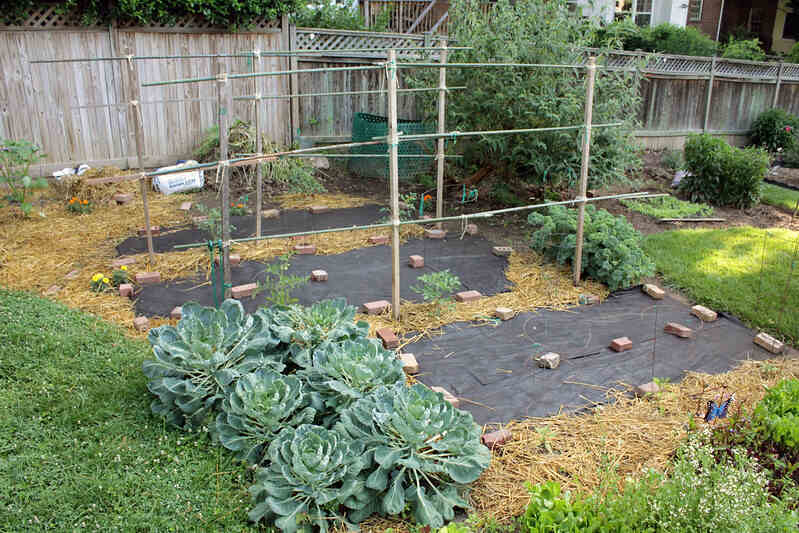
Landscape fabric is a synthetic geotextile that forms a barrier to prevent weeds from sprouting. Unlike plastic sheeting, it lets water and air reach your plants. However, it isn’t a permanent solution.
According to Linda Chalker-Scott, an associate professor at Washington State University, “Geotextiles degrade in the landscape in as little as one year if unprotected from sunlight.”
That’s why they’re often used under a layer of organic mulch like bark or wood chips. These organic mulches also help suppress weeds and extend the lifespan of the fabric by blocking sunlight.
Where to Mulch With Landscape Fabric
Landscape fabric is a great option for areas where you plan to plant perennials because once they’re established, they’ll help shade the fabric and slow its breakdown. However, you can also use landscape fabric:
- Around established trees and shrubs
- On slopes with eroded soil
- Underneath gravel paths
Remember: Skip the fabric in your veggie garden. Over time, it’ll break down and release harmful chemicals into the soil.
Also, avoid using landscape fabric in flower beds where you frequently plant and replant. Moving the fabric to add new plants can mess up your weed control and damage the roots of the plants already growing there.
Pros of Landscape Fabric
- Like black plastic, it prevents sunlight from reaching weed seeds.
- It stabilizes the soil, which helps stop erosion and nutrient loss during heavy rains.
- It naturally suppresses weeds, reducing the need for herbicides.
- It’s customizable.
Cons of Landscape Fabric
- It can get clogged with dirt and debris over time.
- It stops organic matter from decomposing into the soil, which can harm soil health.
- The installation process can be challenging.
See Related:
4. Recycled Rubber

Recycled rubber mulch is made from shredded scrap tires. It’s designed to be a sustainable solution with two main goals: reducing landfill waste and providing a durable, low-maintenance mulch option.
You have to spread the rubber evenly, aiming for a layer about 2- to 3-inches thick. This depth is what you need to keep the soil moist and prevent weeds from sprouting.
Where to Mulch With Rubber
Unfortunately, rubber isn’t the right fit for every part of your yard. As the tires decompose, they release zinc into the soil. While plants need a little to grow, too much zinc can actually stunt their growth, turn their leaves yellow, and even kill them.
That’s why rubber mulch isn’t recommended for vegetable gardens or flower beds. Instead, it works well in areas like:
- Playgrounds
- Pathways
- Decorative spots
Pros of Rubber Mulch
- It can last for many years with minimal maintenance.
- It shields the soil from the impact of rain and wind.
- It has a soft, cushiony surface that absorbs impact.
Cons of Rubber Mulch
- It can get compacted or displaced over time.
- It isn’t as effective as other types of inorganic mulch in preventing weed growth.
- It’s highly flammable and difficult to extinguish if ignited.
See Related: Pros and Cons of Rubber Mulch in Your Landscaping
5. Reflective Mulch
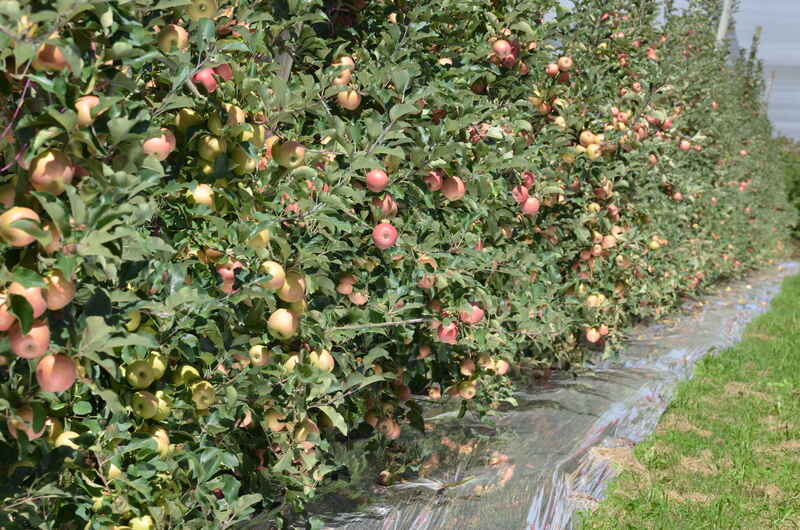
Reflective mulch, also known as metallic or silver mulch, is a type of plastic sheeting with a reflective surface. This means that, unlike black plastic mulch, it bounces sunlight away from the soil, keeping it cooler and helping to reduce water evaporation.
Plus, researchers at the University of California have shown that reflective mulch can deter insects like whiteflies and aphids from feeding on certain vegetables. Just make sure to place the mulch in areas where it won’t be shaded by unpruned vines or tall plants, as this can reduce its effectiveness.
Where to Use Reflective Mulch
Reflective mulches are excellent for vegetable gardens because they increase crop production. You can also use them around fruit trees and berry bushes to help keep pests at bay.
Pros of Reflective Mulch
- It promotes better photosynthesis and plant growth.
- It reduces the need for pesticides.
- It contributes to a cooler soil temperature during hot weather.
- It helps conserve water.
Cons of Reflective Mulch
- It’s difficult to apply once plants are established.
- It’s more expensive than black plastic.
- If you don’t secure it properly, the wind can blow it away.
- Its shiny look might not blend in well with the natural appearance of your garden.
FAQ About Inorganic Mulch
Most inorganic mulches last between three and five years, sometimes even longer, depending on the material, installation quality, and exposure to elements. When it’s time for a change, you’ll notice a few clear signs, such as:
• Visible breakdown
• Fading or discoloration
• Loss of weed suppression
See Related: How Often Should You Replace Mulch?
The price of inorganic mulch depends on the type you choose, its availability, seasonal demand, and your local labor fees, among other things. But if you want to save money and DIY, lava rock mulch costs between $50 and $180 per cubic yard on average, while rubber mulch ranges from $80 to $140 per cubic yard.
Inorganic mulch is a great choice if:
• You want a low-maintenance, long-term landscaping solution
• You prefer a neat and uniform appearance that doesn’t change
• Your landscape is windy
• You have high-traffic areas
• You want to avoid pests
• You need stable soil conditions
Hire a Pro
Adding inorganic mulch is trickier than it seems — you can’t just toss some pebbles or shredded tires around your plants and call it a day. Instead of spending time wrestling with heavy materials or worrying about proper application techniques, hire a local landscaping professional instead.
If you prefer an organic option, why not maximize a resource you already have? Lawn care experts can leave grass clippings on your yard as they mow to create an organic mulch layer that keeps your soil moist and your grass happy. This will also encourage healthier turf growth and help suppress common weeds. Reach out to a lawn mowing professional near you today.
See Related:
Sources:
- International Journal of Scientific & Engineering Research: Pulverized Tires as Soil Amendment for Plant Growth
- UMass Extension Center for Agriculture: Mulch: Using Colored Plastic Mulches in the Vegetable Garden
- University of California Agriculture and Natural Resources: Reflective Mulches
- University of California Kearney Plant Protection Group: Plant Protection Quarterly (v. 7, no. 1)
- Washington State University: The Myth of Landscape Fabric
Main Image Credit: Александр Беспалый / Adobe Stock / License